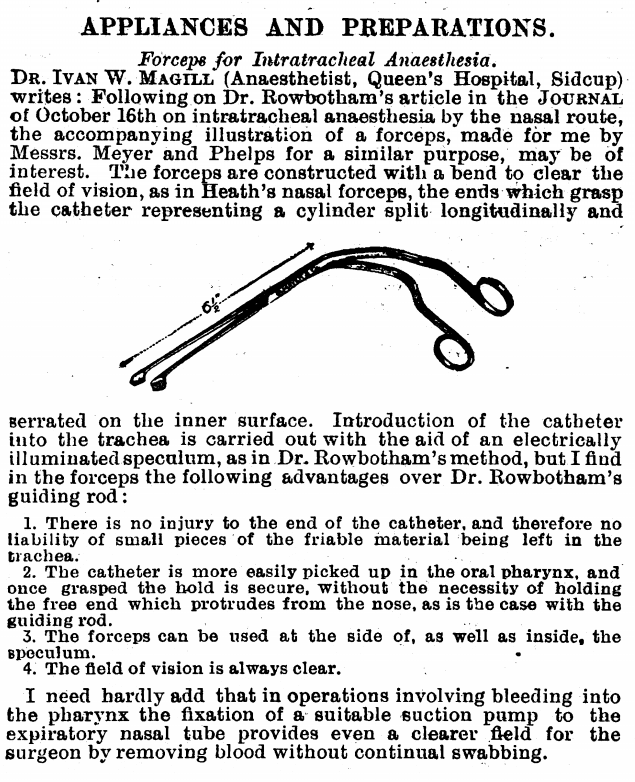Magill forceps
OVERVIEW
- Magill forceps
USES
- aid passage of an endotracheal tube into the larynx (e.g. nasal intubation)
- aid gastric tube passage into the oesophagus
- remove foreign bodies from the airway/ pharynx
- place pharyngeal packs (e.g. bleeding)
DESCRIPTIONS
- Twin-bladed tong-like forceps
- handles for gripping by the user
- rounded ends for grasping
- oblique angle between handles and blades to enable prevent obscuration of the view of the airway during use
- Reusable or disposable (usually stainless steel)
- infant, child and adult sizes
- polished and dull finishes
- open and closed end design to aid gripping of different materials
METHOD OF INSERTION/ USE
- used to grasp objects under direct vision
- best used with a laryngoscope to produce an optimal view of the larynx and displace soft tissues forward to create space for manipulation
COMPLICATIONS
- Local trauma
- breakage of forceps
- unable to grasp small objects (e.g. coin) if inadvertently using open tipped forceps
HISTORY
- Named after its designer Sir Ivan Whiteside Magill (1888-1986), Irish-born pioneer of Anaesthetics
- Originally designed and described in 1920
References and Links
- Sir Ivan Whiteside Magill (1888 – 1986)
- Magill IW. Forceps for intracheal anaesthesia. Br Med J 1920;2:670

Critical Care
Compendium
Chris is an Intensivist and ECMO specialist at The Alfred ICU, where he is Deputy Director (Education). He is a Clinical Adjunct Associate Professor at Monash University, the Lead for the Clinician Educator Incubator programme, and a CICM First Part Examiner.
He is an internationally recognised Clinician Educator with a passion for helping clinicians learn and for improving the clinical performance of individuals and collectives. He was one of the founders of the FOAM movement (Free Open-Access Medical education) has been recognised for his contributions to education with awards from ANZICS, ANZAHPE, and ACEM.
His one great achievement is being the father of three amazing children.
On Bluesky, he is @precordialthump.bsky.social and on the site that Elon has screwed up, he is @precordialthump.
| INTENSIVE | RAGE | Resuscitology | SMACC


